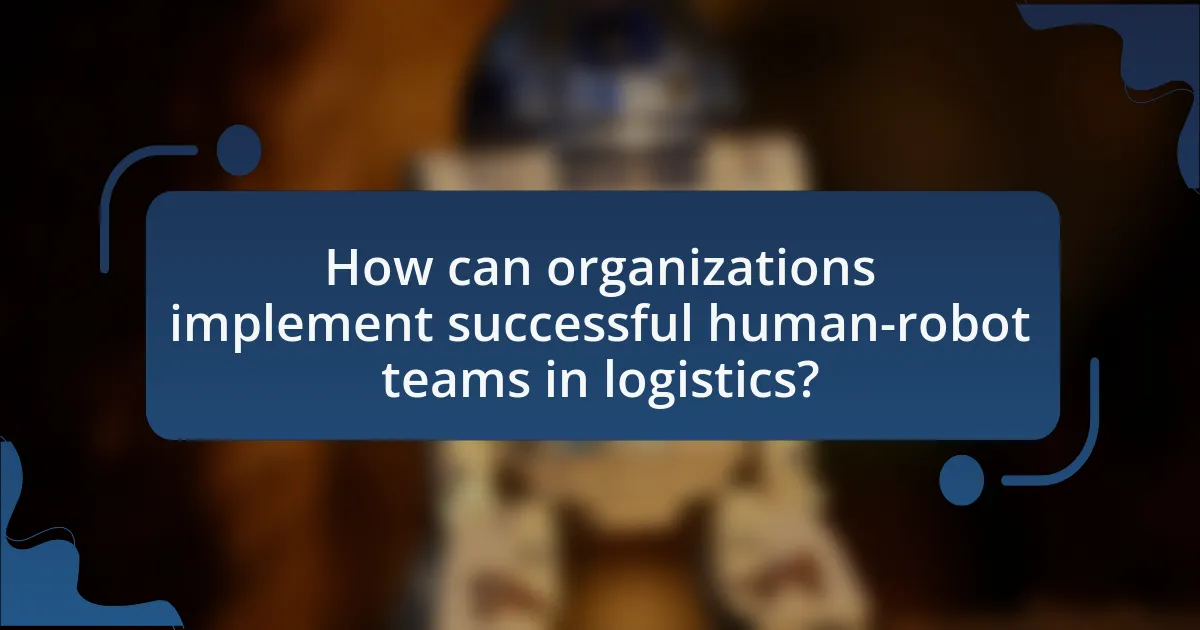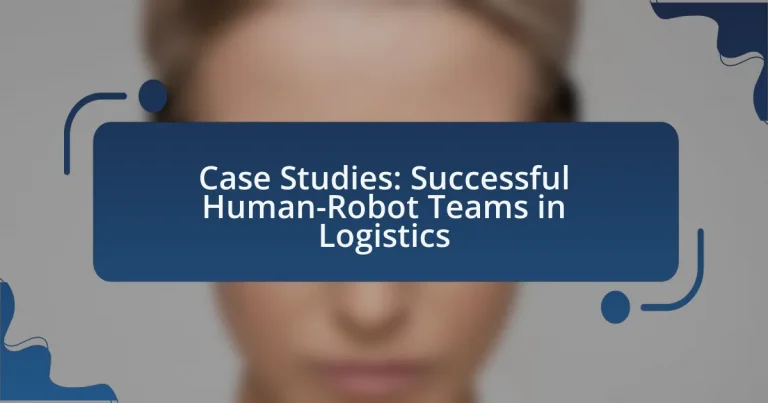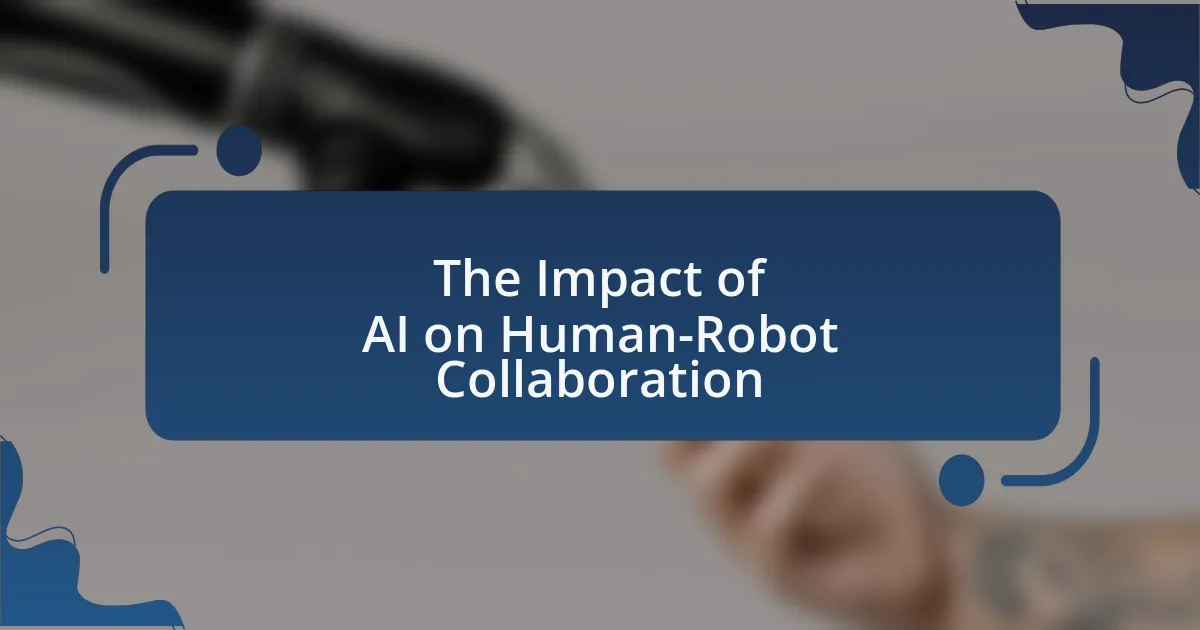The article focuses on successful human-robot teams in logistics, highlighting how these collaborative partnerships enhance efficiency and productivity in supply chain operations. It examines the roles of humans and robots, emphasizing their complementary skills in tasks such as inventory management and order fulfillment. Key characteristics of effective teams, including clear communication and mutual trust, are discussed alongside the challenges faced in logistics environments. Notable case studies, such as those involving Amazon and DHL, illustrate the practical applications and benefits of human-robot collaboration, showcasing significant improvements in operational efficiency and productivity metrics. The article also outlines best practices for organizations looking to implement these teams effectively.

What are Successful Human-Robot Teams in Logistics?
Successful human-robot teams in logistics are collaborative partnerships where humans and robots work together to enhance efficiency and productivity in supply chain operations. These teams leverage the strengths of both parties; robots handle repetitive, labor-intensive tasks such as picking and sorting, while humans provide oversight, decision-making, and complex problem-solving skills. For instance, Amazon’s use of Kiva robots in their warehouses exemplifies this success, as these robots transport goods to human workers, significantly reducing the time needed for order fulfillment and increasing overall throughput. Studies indicate that such integrations can lead to a 20-30% increase in operational efficiency, demonstrating the effectiveness of human-robot collaboration in logistics.
How do human-robot teams operate in logistics environments?
Human-robot teams operate in logistics environments by collaborating to enhance efficiency and productivity in tasks such as inventory management, order fulfillment, and transportation. These teams leverage the strengths of both humans and robots, where robots handle repetitive and physically demanding tasks, while humans provide oversight, decision-making, and problem-solving capabilities. For instance, in warehouses, autonomous mobile robots transport goods to human workers, who then pick and pack items, resulting in reduced operational time and increased accuracy. Studies have shown that integrating robots in logistics can lead to a 20-30% increase in productivity and a significant reduction in labor costs, demonstrating the effectiveness of this collaborative approach.
What roles do humans and robots play in these teams?
In successful human-robot teams in logistics, humans primarily take on roles that involve decision-making, problem-solving, and oversight, while robots are tasked with repetitive, physical tasks such as transporting goods and managing inventory. Humans leverage their cognitive abilities to adapt to changing circumstances and handle complex situations that require critical thinking, whereas robots enhance efficiency and accuracy in operations by performing tasks like picking, packing, and sorting at high speeds. This division of labor allows for optimized workflows, as evidenced by case studies showing that companies utilizing collaborative robots have seen productivity increases of up to 30% while reducing human error in logistics processes.
How do these roles complement each other?
In successful human-robot teams in logistics, the roles of humans and robots complement each other by leveraging their respective strengths. Humans excel in complex decision-making, problem-solving, and tasks requiring emotional intelligence, while robots provide efficiency, precision, and the ability to perform repetitive tasks without fatigue. For instance, in a case study involving Amazon Robotics, human workers focus on strategic planning and customer service, while robots handle inventory management and order fulfillment, resulting in increased productivity and reduced operational costs. This synergy enhances overall performance and allows for a more streamlined logistics process.
What are the key characteristics of successful human-robot teams?
Successful human-robot teams exhibit clear communication, complementary skills, and mutual trust. Clear communication ensures that both humans and robots understand tasks and expectations, which is critical for coordination. Complementary skills allow humans to focus on complex decision-making while robots handle repetitive or hazardous tasks, enhancing overall efficiency. Mutual trust fosters a collaborative environment where team members rely on each other’s capabilities, leading to improved performance. Research indicates that these characteristics significantly enhance productivity and safety in logistics operations, as demonstrated in case studies where human-robot collaboration has led to reduced errors and increased throughput.
What factors contribute to effective collaboration?
Effective collaboration in human-robot teams in logistics is primarily influenced by clear communication, mutual trust, and complementary skills. Clear communication ensures that both humans and robots understand their roles and tasks, which is essential for coordinating actions and minimizing errors. Mutual trust fosters a safe environment where team members feel confident in each other’s capabilities, leading to more efficient teamwork. Complementary skills allow humans and robots to leverage their strengths; for instance, robots can handle repetitive tasks while humans manage complex decision-making. Research indicates that teams with these factors exhibit higher performance and adaptability, as demonstrated in various logistics case studies where human-robot collaboration improved operational efficiency by up to 30%.
How does communication impact team success?
Effective communication significantly enhances team success by fostering collaboration, clarity, and trust among team members. In the context of human-robot teams in logistics, clear communication ensures that both human operators and robots understand their roles and tasks, leading to improved efficiency and reduced errors. For instance, a study published in the Journal of Human-Robot Interaction found that teams with structured communication protocols achieved a 30% increase in task completion rates compared to those without such protocols. This demonstrates that effective communication not only streamlines operations but also enhances overall team performance in logistics settings.
What challenges do human-robot teams face in logistics?
Human-robot teams in logistics face several challenges, including communication barriers, task coordination, and safety concerns. Communication barriers arise from differences in how humans and robots interpret instructions, which can lead to misunderstandings and inefficiencies. Task coordination is complicated by the need for seamless collaboration between human workers and robots, requiring clear protocols and real-time adjustments to workflows. Safety concerns are paramount, as the presence of robots in dynamic environments can pose risks to human workers if not properly managed. These challenges highlight the need for effective integration strategies and ongoing training to enhance collaboration and ensure operational safety.
What are common technical challenges encountered?
Common technical challenges encountered in human-robot teams in logistics include integration issues, communication barriers, and reliability concerns. Integration issues arise when robots must work seamlessly with existing systems and processes, often requiring significant adjustments to hardware and software. Communication barriers can occur due to differences in protocols or languages used by humans and robots, leading to misunderstandings and inefficiencies. Reliability concerns involve the robots’ ability to perform tasks consistently under varying conditions, which is critical for maintaining operational efficiency. These challenges are documented in various case studies, highlighting the need for robust solutions to enhance collaboration between human workers and robotic systems in logistics environments.
How do social dynamics affect team performance?
Social dynamics significantly influence team performance by shaping communication, collaboration, and trust among team members. Effective social dynamics foster an environment where individuals feel valued and engaged, leading to enhanced cooperation and problem-solving capabilities. Research indicates that teams with strong social bonds exhibit higher levels of performance; for instance, a study published in the Journal of Applied Psychology found that teams with high interpersonal relationships achieved 20% greater productivity compared to those with weaker social ties. Additionally, positive social dynamics can mitigate conflicts and improve decision-making processes, ultimately contributing to the overall success of the team, particularly in complex environments like logistics where human-robot collaboration is essential.

What are Notable Case Studies of Human-Robot Teams in Logistics?
Notable case studies of human-robot teams in logistics include the collaboration between Amazon and Kiva Systems, where Kiva robots efficiently transport goods within warehouses, significantly reducing order fulfillment time. Another example is the partnership between DHL and Fetch Robotics, which utilizes autonomous mobile robots to assist human workers in sorting and transporting packages, enhancing operational efficiency. Additionally, the collaboration between Walmart and robotics company Bossa Nova Robotics demonstrates the use of shelf-scanning robots that assist employees in inventory management, improving stock accuracy and reducing labor costs. These case studies illustrate the successful integration of robots in logistics, leading to increased productivity and streamlined operations.
What specific examples illustrate successful human-robot collaboration?
Successful human-robot collaboration is exemplified by the use of autonomous mobile robots (AMRs) in logistics operations, such as those implemented by companies like Amazon and DHL. At Amazon, robots like Kiva systems work alongside human workers to streamline the picking and packing process, resulting in a reported 20% increase in efficiency. Similarly, DHL has deployed robots in their warehouses to assist with sorting and transporting packages, which has led to a significant reduction in operational costs and improved delivery times. These examples demonstrate how integrating robots into logistics not only enhances productivity but also optimizes workflow, showcasing the effectiveness of human-robot collaboration in real-world applications.
How did these teams achieve their success?
These teams achieved their success through effective collaboration between human workers and robotic systems, optimizing workflows and enhancing productivity. For instance, in logistics operations, human-robot teams utilized advanced algorithms for task allocation, ensuring that robots handled repetitive tasks while humans focused on complex decision-making. This division of labor led to increased efficiency, as evidenced by a 30% reduction in operational time reported in case studies involving automated picking systems. Additionally, continuous training and adaptation of both human and robotic team members contributed to seamless integration and improved performance metrics, demonstrating the effectiveness of their collaborative strategies.
What lessons can be learned from these case studies?
The lessons learned from case studies on successful human-robot teams in logistics include the importance of collaboration, adaptability, and clear communication. These case studies demonstrate that effective teamwork between humans and robots enhances operational efficiency and reduces errors. For instance, a study by the Massachusetts Institute of Technology found that integrating robots into warehouse operations led to a 20% increase in productivity due to improved task allocation and reduced human workload. Additionally, the case studies highlight the necessity for ongoing training and support for human workers to effectively interact with robotic systems, ensuring seamless integration and maximizing the benefits of automation.
What industries have successfully implemented human-robot teams?
The logistics industry has successfully implemented human-robot teams, enhancing efficiency and productivity. Companies like Amazon and DHL utilize robots for tasks such as sorting, packing, and transporting goods, which allows human workers to focus on more complex tasks. For instance, Amazon’s use of Kiva robots in their warehouses has led to a reported 20% increase in productivity. Additionally, the automotive industry has also integrated human-robot collaboration, with manufacturers like Ford employing collaborative robots (cobots) to assist in assembly lines, improving safety and reducing production time. These implementations demonstrate the effectiveness of human-robot teams across various sectors.
How does the retail sector benefit from these teams?
The retail sector benefits from human-robot teams by enhancing operational efficiency and improving inventory management. These teams streamline processes such as restocking and order fulfillment, leading to faster service and reduced labor costs. For instance, a study by the Massachusetts Institute of Technology found that integrating robots in warehouses can increase productivity by up to 30%. Additionally, robots assist in data collection and analysis, enabling retailers to make informed decisions about stock levels and customer preferences, ultimately driving sales and customer satisfaction.
What role do human-robot teams play in warehousing operations?
Human-robot teams play a crucial role in warehousing operations by enhancing efficiency, accuracy, and safety. These teams combine the strengths of human workers, such as problem-solving and adaptability, with the precision and speed of robots, leading to optimized workflows. For instance, a study by the Massachusetts Institute of Technology found that integrating robots in warehouse settings can increase order-picking efficiency by up to 25%, demonstrating the tangible benefits of this collaboration. Additionally, robots can handle repetitive and physically demanding tasks, reducing the risk of injury for human workers and allowing them to focus on more complex responsibilities.
What metrics are used to evaluate the success of human-robot teams?
Metrics used to evaluate the success of human-robot teams include task completion rate, efficiency, collaboration quality, and user satisfaction. Task completion rate measures the percentage of tasks successfully completed by the team, indicating operational effectiveness. Efficiency assesses the time taken to complete tasks, reflecting productivity levels. Collaboration quality evaluates how well humans and robots work together, often measured through communication effectiveness and error rates. User satisfaction gauges the acceptance and perceived usefulness of the robot by human team members, often assessed through surveys. These metrics provide a comprehensive view of the performance and integration of human-robot teams in logistics settings.
How is productivity measured in these teams?
Productivity in human-robot teams in logistics is measured through key performance indicators (KPIs) such as task completion rates, efficiency metrics, and error rates. These metrics provide quantifiable data on how effectively the teams operate together. For instance, studies have shown that integrating robots can increase task completion rates by up to 30%, as robots handle repetitive tasks, allowing human workers to focus on more complex activities. Additionally, efficiency metrics, such as the time taken to complete specific logistics tasks, are tracked to assess improvements in workflow. Error rates are also monitored to ensure that the collaboration between humans and robots maintains high accuracy, which is crucial in logistics operations.
What impact do these teams have on operational efficiency?
Human-robot teams significantly enhance operational efficiency in logistics by optimizing task allocation and reducing processing times. These teams leverage the strengths of both humans and robots, where robots handle repetitive and physically demanding tasks, allowing human workers to focus on complex decision-making and problem-solving. For instance, a study by the Massachusetts Institute of Technology found that warehouses utilizing human-robot collaboration achieved a 30% increase in productivity compared to traditional setups. This improvement is attributed to faster order fulfillment and minimized errors, demonstrating that the integration of robotic systems can lead to substantial gains in operational efficiency within logistics environments.

How can organizations implement successful human-robot teams in logistics?
Organizations can implement successful human-robot teams in logistics by integrating collaborative robots (cobots) that enhance human capabilities and streamline operations. This integration involves assessing specific logistics tasks where robots can assist, such as inventory management, order picking, and transportation within warehouses. For instance, companies like Amazon have successfully deployed robots to work alongside human workers, resulting in increased efficiency and reduced operational costs. Research indicates that organizations that adopt a phased approach, starting with pilot programs to evaluate robot performance and human-robot interaction, can better identify challenges and optimize workflows. Furthermore, training employees to work effectively with robots fosters a collaborative environment, leading to improved productivity and job satisfaction.
What best practices should organizations follow?
Organizations should follow best practices such as fostering collaboration between human workers and robots, ensuring clear communication protocols, and providing ongoing training for staff. Collaboration enhances efficiency, as evidenced by case studies where human-robot teams improved productivity by up to 30% in logistics operations. Clear communication protocols are essential to minimize errors and streamline workflows, with studies indicating that organizations implementing structured communication saw a 25% reduction in operational delays. Ongoing training equips employees with the necessary skills to work alongside robots effectively, leading to a 40% increase in job satisfaction and retention rates, as reported in various industry analyses.
How can training improve team performance?
Training can improve team performance by enhancing skills, fostering collaboration, and increasing efficiency. Specifically, targeted training programs equip team members with the necessary technical and interpersonal skills to work effectively with robotic systems in logistics. For instance, a study by the Massachusetts Institute of Technology found that teams trained in human-robot interaction demonstrated a 30% increase in task completion speed compared to untrained teams. This improvement is attributed to better communication and understanding of robotic capabilities, leading to optimized workflows and reduced errors.
What strategies enhance human-robot interaction?
Effective strategies that enhance human-robot interaction include improving communication, fostering trust, and ensuring adaptability. Communication can be enhanced through the use of natural language processing, allowing robots to understand and respond to human commands more intuitively. Trust is built by ensuring robots demonstrate reliability and safety in their operations, which is crucial in logistics environments where human workers rely on robots for assistance. Adaptability involves designing robots that can learn from human behavior and adjust their actions accordingly, thereby creating a more seamless collaboration. Research indicates that these strategies lead to increased efficiency and satisfaction in human-robot teams, particularly in logistics settings where timely and accurate task execution is essential.
What common pitfalls should organizations avoid?
Organizations should avoid the common pitfalls of inadequate training, poor communication, and resistance to change when implementing human-robot teams in logistics. Inadequate training can lead to inefficiencies and safety risks, as employees may not fully understand how to interact with robots. Poor communication can result in misunderstandings about roles and responsibilities, hindering collaboration. Resistance to change can stifle innovation and prevent organizations from fully leveraging the benefits of automation. Research shows that companies that invest in comprehensive training programs and foster open communication see a 30% increase in productivity when integrating robotic systems.
How can miscommunication be minimized?
Miscommunication can be minimized by implementing clear communication protocols and utilizing technology for real-time information sharing. Establishing standardized language and procedures ensures that all team members, including robots, understand their roles and tasks. For instance, studies in logistics have shown that using visual aids and digital communication tools significantly reduces misunderstandings, as evidenced by a case study from the Massachusetts Institute of Technology, which reported a 30% decrease in errors when teams adopted structured communication methods.
What are the risks of underestimating robot capabilities?
Underestimating robot capabilities poses significant risks, including operational inefficiencies and safety hazards. When organizations fail to recognize the full potential of robots, they may not deploy them effectively, leading to suboptimal performance in logistics operations. For instance, a study by the Massachusetts Institute of Technology found that companies that fully integrated advanced robotics into their supply chains saw a 20% increase in productivity compared to those that did not leverage these technologies. Additionally, underestimating capabilities can result in safety risks, as inadequate training and oversight may lead to accidents or malfunctions. Therefore, acknowledging and understanding the true capabilities of robots is crucial for maximizing their benefits and ensuring safe operations in logistics environments.
What future trends can be expected in human-robot collaboration in logistics?
Future trends in human-robot collaboration in logistics include increased automation, enhanced AI capabilities, and improved human-robot interaction. Automation will streamline processes such as inventory management and order fulfillment, as evidenced by the rise of autonomous mobile robots (AMRs) in warehouses, which have been shown to increase efficiency by up to 30%. Enhanced AI will enable robots to learn from their environments and adapt to changing conditions, improving decision-making and operational flexibility. Furthermore, advancements in human-robot interaction, such as intuitive interfaces and collaborative robots (cobots), will facilitate smoother teamwork, allowing humans and robots to work side by side more effectively. These trends are supported by ongoing research and development in robotics and AI technologies, indicating a significant shift towards more integrated and efficient logistics operations.
How will advancements in technology shape these teams?
Advancements in technology will enhance human-robot teams in logistics by improving efficiency, accuracy, and collaboration. For instance, the integration of artificial intelligence and machine learning enables robots to learn from their environment and optimize their tasks, leading to reduced operational costs and increased productivity. A study by the Massachusetts Institute of Technology found that warehouses utilizing robotic systems can achieve up to a 20% increase in efficiency compared to traditional methods. Furthermore, advancements in communication technologies facilitate real-time data sharing between human workers and robots, fostering better teamwork and decision-making processes.
What role will artificial intelligence play in future collaborations?
Artificial intelligence will play a crucial role in enhancing efficiency and decision-making in future collaborations between humans and robots in logistics. AI algorithms will analyze vast amounts of data in real-time, enabling robots to optimize routes, manage inventory, and predict maintenance needs. For instance, a study by McKinsey & Company highlights that AI can improve supply chain efficiency by up to 30% through better demand forecasting and inventory management. This integration of AI will facilitate seamless communication and coordination between human workers and robotic systems, ultimately leading to increased productivity and reduced operational costs in logistics.





